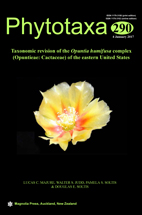Abstract
The Humifusa clade represents a recent radiation that originated in the late Pliocene or early Pleistocene and consists of about 10 species widely distributed in North America from northern Mexico north to Ontario, Canada, and south to the Florida Keys. This clade likely originated in the edaphically subxeric regions of northern Mexico and the southwestern United States, and from there it later spread to the southeastern United States and ultimately produced a small radiation in the eastern United States. Hybridization among evolutionarily divergent diploid species of the southeastern (SE) and southwestern (SW) United States subclades led to the origin of many polyploid taxa, which today occupy about 75% of the distribution of the clade. Here we present a taxonomic revision of the SE subclade of the Humifusa clade and polyploid derivatives that commonly occur in the eastern United States (i.e., the O. humifusa complex). We recognize eight taxa: Opuntia abjecta, O. austrina, O. cespitosa, O. drummondii, O. humifusa, O. mesacantha subsp. mesacantha, O. mesacantha subsp. lata, and O. nemoralis, as well as the interclade allopolyploid, Opuntia ochrocentra, derived, in part, from a member of the O. humifusa complex. Diagnostic keys, descriptions, original photos, and distribution maps are provided for each taxon. Neotypes are designated for the names O. austrina (NY) and O. youngii (USF), and O. drummondii and O. tracyi are lectotypified from an illustration in Maund & Henslow and a specimen at NY, respectively.

